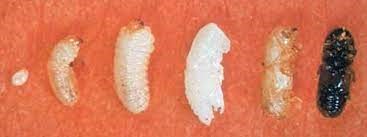Advancing invasive pests and pathogens are novel species with the potential to disrupt forest ecosystems. Extreme cold typically limits the spread of many invasives into our region, but as temperatures increase across the region, so does the threat of invasive species. Novel pest introductions often lead to severe defoliation and tree mortality due to lack of natural biological controls and unanticipated, irregular life cycle dynamics. Tracking the advance of novel invasive species can help quantify impact and inform management to mitigate those impacts. High priority pest/pathogen species included in this analysis are Southern Pine Beetle, Hemlock Woolly Adelgid, and Emerald Ash Borer. Due to the fairly recent introduction of these pests into the region, we did not include frequency in the analysis. Others, such as beech leaf disease and oak wilt, are increasingly of concern, but do not yet have enough occurrences across the region to analyze.
Southern pine beetle (SPB) is a small bark beetle that is native to the southeastern US and primarily infects pine trees, but may also damage hemlock and spruce. Its range has expanded eastward as temperatures warm in the region. In the southwest, fires play a key role in mitigating the impacts of SPB by thinning pine stands and disrupting pheromone communication among SPB populations. It is anticipated that as the climate of the northeast continues to change and warm, southern pine beetle will become an increasing concern. Using the 100 years of Aerial Survey data aggregated in the FEMC Northeastern Forest Health Atlas we extracted records of damage attributed to southern pine beetle across the region.

As a relatively new species to the northeast, the historical record of southern pine beetle damage only goes back to 2015.
| Data Program | Years | Org | Data Products |
|---|